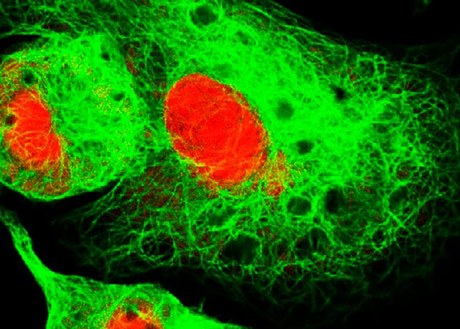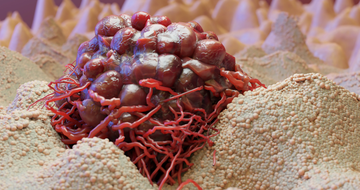FDA approves eflornithine for adult and pediatric patients with high-risk neuroblastoma
What is the potential role for eflornithine in the treatment of high-risk neuroblastoma?
- Eflornithine (difluoromethylornithine, DFMO, Iwilfin) is a first-in-class ornithine decarboxylase inhibitor which inhibits polyamine synthesis and restores the LIN28/Let-7 metabolic pathway. This reduces the expression of MYCN and LIN28B in MYCN-amplified neuroblastoma.1
- Eflornithine is approved to reduce relapse risk in adult and pediatric patients with high-risk neuroblastoma who achieved at least a partial response to prior multimodal and multiagent therapy including use of anti-GD2 immunotherapy (e.g. dinutuximab). Approval was based on analyses from the phase II, multicenter, non-randomized NMTRC003B trial.1
- In the recent publication2, eflornithine-treated patients in NMTRC003B were compared to an external control population consisting of patient-level data from ANBL0032 who did not receive eflornithine. Eflornithine was dosed at 750 ± 250 mg/m2 twice daily for 2 years and initiated after completion of immunotherapy in patients who were in initial remission.
- For the primary endpoint, a statistically significant improvement in event free survival (EFS) was seen in the 92 eflornithine-treated patients as compared with the 852 control patients (4-year EFS 84% vs 72%, HR=0.50, 95% CI 0.29-0.84, p=0.008). A statistically significant improvement in overall survival (OS) was also seen in the eflornithine-treated group compared with the control (4-year OS 96% vs 84%, HR=0.38, 95% CI 0.19-0.76, p=0.007). Confirmatory results were seen in a 3:1 propensity score-matching analysis, as well as multiple sensitivity analyses, suggesting a consistent benefit in EFS and OS with the addition of eflornithine.2
- Common adverse effects of eflornithine included otitis media (32%), sinusitis (13%), pneumonia (12%), upper respiratory tract infection (11%), conjunctivitis (11%), diarrhea (15%), vomiting (11%), cough (15%), allergic rhinitis (11%), and pyrexia (11%). No grade 3 adverse effect had an incidence greater than 10%.1
- The National Comprehensive Cancer Network (NCCN) recommends the consideration of eflornithine as continuation therapy after completion of anti-GD2 antibody-containing post-consolidation therapy in those who have responded to prior therapy (category 2B).3
- Given the high mortality rate associated with relapsed high-risk neuroblastoma, eflornithine offers a novel and promising avenue to reduce relapse risk and improve survival in this patient population.
What role can the pharmacist play in the management of patients on eflornithine?
- Dosing is based on body surface area:1
| BSA (m2) | Dosage | |
|---|---|---|
| >1.5 | 768 mg (4 tablets) by mouth twice daily | |
| 0.75 to 1.5 | 576 mg (3 tablets) by mouth twice daily | |
| 0.5 to <0.75 | 384 mg (2 tablets) by mouth twice daily | |
| 0.25 to < 0.5 | 192 mg (1 tablet) by mouth twice daily |
- No drug-drug interactions are noted in the package insert.1
- Significant adverse effects of eflornithine include myelosuppression (grade 3/4 neutropenia in 4.2%, febrile neutropenia in 0.6%, grade 3/4 thrombocytopenia in 1.4%, grade 3 anemia in 3.3%), hepatotoxicity (grade 3/4 ALT elevation in 11%, AST elevation in 6%, and bilirubin elevation in 0.3%), and hearing loss that may be permanent (13% new or worsening hearing loss, 12% worsened from baseline to grade 3/4, 7% required hearing aids).1
- If experiencing toxicity, reduce dose by 1 tablet (192 mg) as noted below. If unable to tolerate minimum dose of 192 mg, permanently discontinue therapy.1
- Dose modifications for specific adverse reactions:
- Myelosuppression: Withhold eflornithine for neutrophils <500/mm3, platelets <25,000/mm3, or hemoglobin <8 g/dL. For neutrophils and platelets, resume same dose if counts recover within 7 days, and reduce by one dose level if counts recover after 7 days. If platelets remain <25,000/mm3 after 14 days, permanently discontinue eflornithine. Once hemoglobin recovers, resume same dose. If anemia recurs, withhold until count recovery, and reduce dose one level.
- Hepatotoxicity: Withold eflornithine for AST or ALT elevations ≥ 10x ULN. Resume same dose if recover within 7 days or reduce by one dose level if recover past 7 days.
- Hearing loss: If new or worsening hearing loss is noted from baseline audiogram, continue same dose, and repeat audiogram in 3 weeks. If improved at 3 weeks, continue same dose. If worsening persists, hold for 30 days, and repeat audiogram. If stable or improved after 30 days, reduce dose by one dose level.
- Nausea, vomiting, diarrhea (grade 3): Continue if responsive to supportive treatment. If unresponsive, hold until less than grade 2 and reduce by one dose level.
- Other adverse reaction (grade 3-4): Hold until less than grade 2 and reduce by one dose level.
- Other adverse reaction (recurrent grade 4): Permanently discontinue eflornithine.
Clinical Pearls
- Dosage Form and Strengths: 192 mg tablets1
- Eflornithine tablets may be chewed or crushed and mixed with 2 tablespoons of soft food or liquid. The crushed product must be discarded after 1 hour.1
- Eflornithine may be taken with our without food.1
- Store at room temperature.1
- Females of reproductive potential and their partners should use contraception during and for 1 week after treatment given risk of embryo-fetal toxicity.1
- Monitoring parameters: Monitor for myelosuppression (neutrophils, platelets, and hemoglobin) prior to initiation and periodically during treatment. Monitor for hepatotoxicity by obtaining LFTs prior to start of treatment, monthly for the first 6 months, and every 3 months thereafter, or as clinically indicated. Monitor for hearing loss by performing an audiogram prior to initiation of therapy and every 6 months, or as clinically indicated.1
- For financial or co-payment assistance for eflornithine, information on the IWILFIN Cares program is available at4: https://hcp.iwilfin.com/access-resources/#treatment-access
References
- US WorldMeds. Eflornithine [package insert]. U.S. Food and Drug Administration website. https://www.accessdata.fda.gov/drugsatfda_docs/label/2023/215500s000lbl.pdf. Revised [12/2023]. Accessed [1/31/2024].
- Oesterheld J, Ferguson W, Kraveka JM, et al. Eflornithine as Postimmunotherapy Maintenance in High-Risk Neuroblastoma: Externally Controlled, Propensity Score–Matched Survival Outcome Comparisons. J Clin Oncol. Published online October 26, 2023. doi:10.1200/JCO.22.02875
- National Comprehensive Cancer Network. Neuroblastoma. (Version 1.2024 - February 7, 2024). https://www.nccn.org/professionals/physician_gls/pdf/neuroblastoma.pdf. Accessed February 8, 2024.
- IWILFIN Cares™ https://hcp.iwilfin.com/access-resources/#treatment-access. Accessed March 4, 2024.



